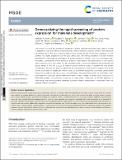| dc.contributor.author | Morris, Melody A. | |
| dc.contributor.author | Bataglioli, Rogério A. | |
| dc.contributor.author | Mai, Danielle J. | |
| dc.contributor.author | Yang, Yun Jung | |
| dc.contributor.author | Paloni, Justin M. | |
| dc.contributor.author | Mills, Carolyn E. | |
| dc.contributor.author | Schmitz, Zachary D. | |
| dc.contributor.author | Ding, Erika A. | |
| dc.contributor.author | Huske, Allison C. | |
| dc.contributor.author | Olsen, Bradley D. | |
| dc.date.accessioned | 2022-12-14T15:12:11Z | |
| dc.date.available | 2022-12-14T15:12:11Z | |
| dc.date.issued | 2023 | |
| dc.identifier.issn | 2058-9689 | |
| dc.identifier.uri | https://hdl.handle.net/1721.1/146872 | |
| dc.description.abstract | The function, structure, and mechanical properties of protein materials make them well-suited for a range of applications such as biosensors and biomaterials. Unlike in traditional polymer synthesis, their sequences are defined and, in the case of recombinant proteins, dictated by the chosen DNA sequence. As DNA synthesis has rapidly progressed over the past twenty years, the limiting bottleneck in protein materials development is the empirical optimization of protein expression. Herein, a low-cost, automated, high-throughput, combinatorial protein expression platform is developed to test permutations of DNA vectors and Escherichia coli (E. coli) strains in a 96-well plate format. Growth and expression are monitored with optical density at 600 nm (OD600) to measure growth, Bradford assays to establish the total protein concentration, and dot blot assays to determine the concentration of the protein of interest. With an eye toward accessibility for researchers without suites of biosynthetic equipment, automated camera-based assays are validated for the OD600 assay, via turbidimetry, and the Bradford assay, via colorimetry. High-yield expression conditions can be determined within a week. Notably, in several cases, previously un-expressible proteins are expressed successfully in viable yields. Collectively, an efficient approach to overcoming long-running synthesis challenges in protein materials development is established, which will expedite materials innovation. | en_US |
| dc.publisher | Royal Society of Chemistry (RSC) | en_US |
| dc.relation.isversionof | 10.1039/d2me00150k | en_US |
| dc.rights | Creative Commons Attribution 3.0 unported license | en_US |
| dc.rights.uri | https://creativecommons.org/licenses/by/3.0/ | en_US |
| dc.source | Royal Society of Chemistry (RSC) | en_US |
| dc.subject | Materials Chemistry | en_US |
| dc.subject | Industrial and Manufacturing Engineering | en_US |
| dc.subject | Process Chemistry and Technology | en_US |
| dc.subject | Energy Engineering and Power Technology | en_US |
| dc.subject | Biomedical Engineering | en_US |
| dc.subject | Chemical Engineering (miscellaneous) | en_US |
| dc.subject | Chemistry (miscellaneous) | en_US |
| dc.title | Democratizing the rapid screening of protein expression for materials development | en_US |
| dc.type | Article | en_US |
| dc.identifier.citation | Morris, Melody A., Bataglioli, Rogério A., Mai, Danielle J., Yang, Yun Jung, Paloni, Justin M. et al. 2023. "Democratizing the rapid screening of protein expression for materials development." | |
| dc.contributor.department | Massachusetts Institute of Technology. Department of Chemical Engineering | en_US |
| dc.eprint.version | Final published version | en_US |
| dc.type.uri | http://purl.org/eprint/type/JournalArticle | en_US |
| eprint.status | http://purl.org/eprint/status/PeerReviewed | en_US |
| dspace.date.submission | 2022-12-14T14:27:10Z | |
| mit.license | PUBLISHER_CC | |
| mit.metadata.status | Authority Work and Publication Information Needed | en_US |
